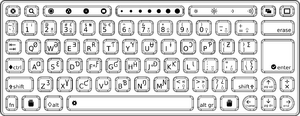Talk:OLPC Nigeria Keyboard: Difference between revisions
| Line 34: | Line 34: | ||
--[[User:Walter|Walter]] 12:23, 2 November 2007 (EDT) |
--[[User:Walter|Walter]] 12:23, 2 November 2007 (EDT) |
||
Never use characters in the E000 to F8FF range. These are non-standard. Many are in conflict with LANANA assignments, which are the controlling authority here. The characters in question are as in the table below. [[User:AlbertCahalan|AlbertCahalan]] 02:49, 3 November 2007 (EDT) |
|||
SIL F214, Unicode 024C, R with stroke |
|||
SIL F215, Unicode 2C64, R with tail |
|||
SIL F218, Unicode 0244, U with bar |
|||
SIL F21B, Unicode 2C70 '''''proposed''''', W with hook |
|||
Revision as of 06:49, 3 November 2007
Upstream and design question
Hi. Why isn’t this keyboard layout upstream in freedesktop? Is the design of the layout related to the NITDA keyboard? --Moyogo 04:34, 4 September 2007 (EDT)
- We are moving all of our keyboard layouts upstream. We are also trying to adhere to the existing XKB symbol files where possible. In the case of Nigeria, we did not only take into account Yoruba, as per the NITDA keyboard, but also added a number of additional glyphs to support other Western Africa languages. We opted to use the Unicode "combining" keys for the accent characters, but the basic functionality is the same. (We use the Alt Gr key rather than Shift and Ctrl.) --Walter 07:00, 4 September 2007 (EDT)
- FYI, We are using overlays exensively for Amharic. But it is probably more overhead than is necessary for just adding relatviely standard Latin accents such as dot below or dot above. Also, one could opt for the XKB "dead key" approach, but X does not currently have dead keys assigned to all of the standard accents. --Walter 03:27, 5 September 2007 (EDT)
Some remarks
Not sure where you are with production on this particular layout. I'd be hesitant to call it West African at this stage. Several points:
- The capital "eng" (velar n) should be the n-form (like a larger version of the lower case) and not the N-form (similarly for the palatal n character)
- There are some characters missing - no tailed d which would be used in Ewe for instance; no open e that is used in several languages
- Some people might be more comfortable with some different placements of the extended characters (why for instance is the hooked y with r rather than y? ; the r key might be reserved for another character).
The issue of keyboards for various configurations of languages and countries in parts of Africa where extended orthographies are used is not new. There was a lot of discussion of considerations for keyboards a few years ago on A12n-collaboration and some keyboard layouts informed to one degree or another by that on this page. More recently there have been a lot of African keyboard layouts for Keyman and MSKLC, not to mention the Konyin keyboard for Nigeria.
There are a lot of alternative layouts - too many perhaps - but a lot of examples from which to work. Ultimately, per discussion we had on A12n-collab and elsewhere, one might want to think in terms of more than one standard keyboard for some configurations of countries in a region like West and Central Africa. Obviously there would be an issue of QWERTY and AZERTY keyboards. But a basic focus would be on what characters are used in orthographies of what languages where. That kind of information is out there, and collated to some degree and with some questions about its accuracy or currency - for instance in these country tables and this database. More work is needed.
And indeed there will at some point soon be a need for authorities that can weigh in for one or another standard to do so. Nigeria with the NITDA keyboard has been an exception in this area, though that particular keyboard had some criticisms.
Sorry if this sounds critical - it is meant constructively and I hope it is useful. I do realize you're undertaking a lot of work. Let's communicate more on this, since it relates to emerging discussions re localization and standards. --Don 03:50, 27 October 2007 (EDT)
- Actually, this is very helpful. Getting feedback re this keyboard has been difficult. --Walter 04:29, 27 October 2007 (EDT)
- I've posted a request for feedback on the A12n-collab list and cc'd you - hopefully will generate some feedback there and here. Some of the back correspondence on A12n-collab may be of interest. Also perhaps some of the topics addressed on some of the several language or country specific message boards (on a given board, click on "All messages" and use a simple Ctrl-f search for keywords - keyboards have come up as a topic in various places). If more reading is in order (!), there is some background on keyboards in Africa and discussion of standards in a larger report on localization in Africa (that is in the process of revision). --Don 13:28, 27 October 2007 (EDT)
- Thanks. --Walter 13:43, 27 October 2007 (EDT)
Taking Don's feedback to heart, I've sketched out a new version of the West African keyboard:
I generally followed the SIL layout, but as we are using Alt-gr instead of deadkeys, I made a few changes. Also, I couldn't readily find glyphs for U+F21B, U+F218, U+F215, and U+F214, so I haven't included those characters. Any comments regarding what to do about these?
--Walter 12:23, 2 November 2007 (EDT)
Never use characters in the E000 to F8FF range. These are non-standard. Many are in conflict with LANANA assignments, which are the controlling authority here. The characters in question are as in the table below. AlbertCahalan 02:49, 3 November 2007 (EDT)
SIL F214, Unicode 024C, R with stroke SIL F215, Unicode 2C64, R with tail SIL F218, Unicode 0244, U with bar SIL F21B, Unicode 2C70 proposed, W with hook
